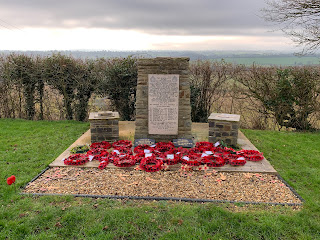In November 2021 I was invited by the Royal British Legion to attend a ceremony of remembrance at the Commonwealth War Graves plot in Milton Cemetery, Weston-super-Mare. The particular focus of this event, were twenty three men who had been killed when their Horsa glider broke apart in mid-air over the village of Paulton near Bristol. On Sunday, 17 September 1944 at 10:25, a Short Stirling of 299 Squadron had taken off from RAF Keevil in Wiltshire, towing Horsa Glider RJ113. The entire complement of the glider was lost when the glider disintegrated - twenty one men of 1 Platoon, 9th (Airborne) Field Company, Royal Engineers and two crew from the Glider Pilot Regiment.
Wreaths were laid on behalf of The Volunteer Training Development Team at Regional Command, The Bristol Royal Engineers Association, The Glider Pilot Regiment Society, The Royal British Legion and The Double Hills Arnhem Commemoration Committee. Fittingly, a final wreath was laid on behalf of Mrs Valerie Austin, daughter of Sapper John Fernyhough - one of the casualties. After the Collect of The Army Air Corps and the Collect of The Royal Engineers, the padre asked those present to remember with thanksgiving all those who have died on operational service, especially the 23 soldiers who died aboard glider RJ113, the first casualties of Operation Market Garden. The customary two minutes silence was observed and flags were paraded.
After the incident the Stirling tow aircraft returned to RAF Keeble. The crash site had been marked and the crew of the bomber resolved to travel back to Somerset by jeep and find their lost comrades. Simpson remembered what he and his skipper found.
Apparently the other half of the RE platoon was flying a glider just below and watched, with understandable horror, the wreckage floating downwards. The tail fell in a roadway and the fuselage section fell in a field on a feature known locally as Double Hills. The cause of the accident was never established.
One can get a sense of what the interior of a Horsa was like by visiting the example in the Cobbaton Military Vehicle Collection in Devon. The replica shown in the image above was built for the film A Bridge to Far.
A couple of months after the ceremony in Weston-super-Mare I took a trip out to the crash site which is a short walk out of the village of Paulton in the Mendip Hills. The spot is marked by a rather impressive memorial which lists the names of those who were killed. A plaque informs the visitor that the memorial was unveiled - very appropriately - by the commander of the British 1st Airborne Division at Arnhem, Major General R.E. Urquhart CB. DSO. on the 23rd September 1979.
 |
| My photo - Jan 2022 |
 |
| Earlier photo - Undated |
The memorial is clearly looked after. Indeed some of the names of those who have been involved in its upkeep are recorded on the site. The memorial was flanked by two striking sculptures but both are gone (presumed stolen) - as shown in the second undated photo. A plaque records the one on the right has having been a sapper of the 9th Field Company (Airborne) Royal Engineers. Created and donated by SPR Roy Cleeves 2008.
Since writing this article, I have had some interesting correspondence with Ramon de Heer who has researched the first Arnhem casualties. By studying contemporary documents, he has established that Horsa 240 towed by Dakota KG318 was lost a few minutes before the Double Hills crash. The pilot, Sgt Thomas A. Joyce, was killed when his glider hit high tension cables whilst attempting a forced landing near Tring in Hertfordshire. Tug and glider had taken off at 9:53 from RAF Down Ampney.

















